Importance of Stock Control: Purpose, Types, and Management Methods
VerifiedAdded on 2019/10/18
|11
|2645
|120
Report
AI Summary
This report comprehensively examines the purpose of stock control within a business context, emphasizing its critical role in preventing stockouts and optimizing inventory levels. It details the different types of stocks, including raw materials, work in progress, finished goods, and consumables, and explains the importance of determining optimal stock quantities. The report further explores various stock control mechanisms, such as perpetual and periodic systems, along with the utilization of barcode and radio frequency identification (RFID) technologies. Finally, it delves into diverse methods for stock control management, including setting safe stock levels, stock reviews, just-in-time inventory, ABC analysis, and economic order quantity, providing a holistic understanding of efficient inventory management strategies. The report highlights the importance of stock control in achieving customer satisfaction, managing costs, and maintaining a competitive edge.
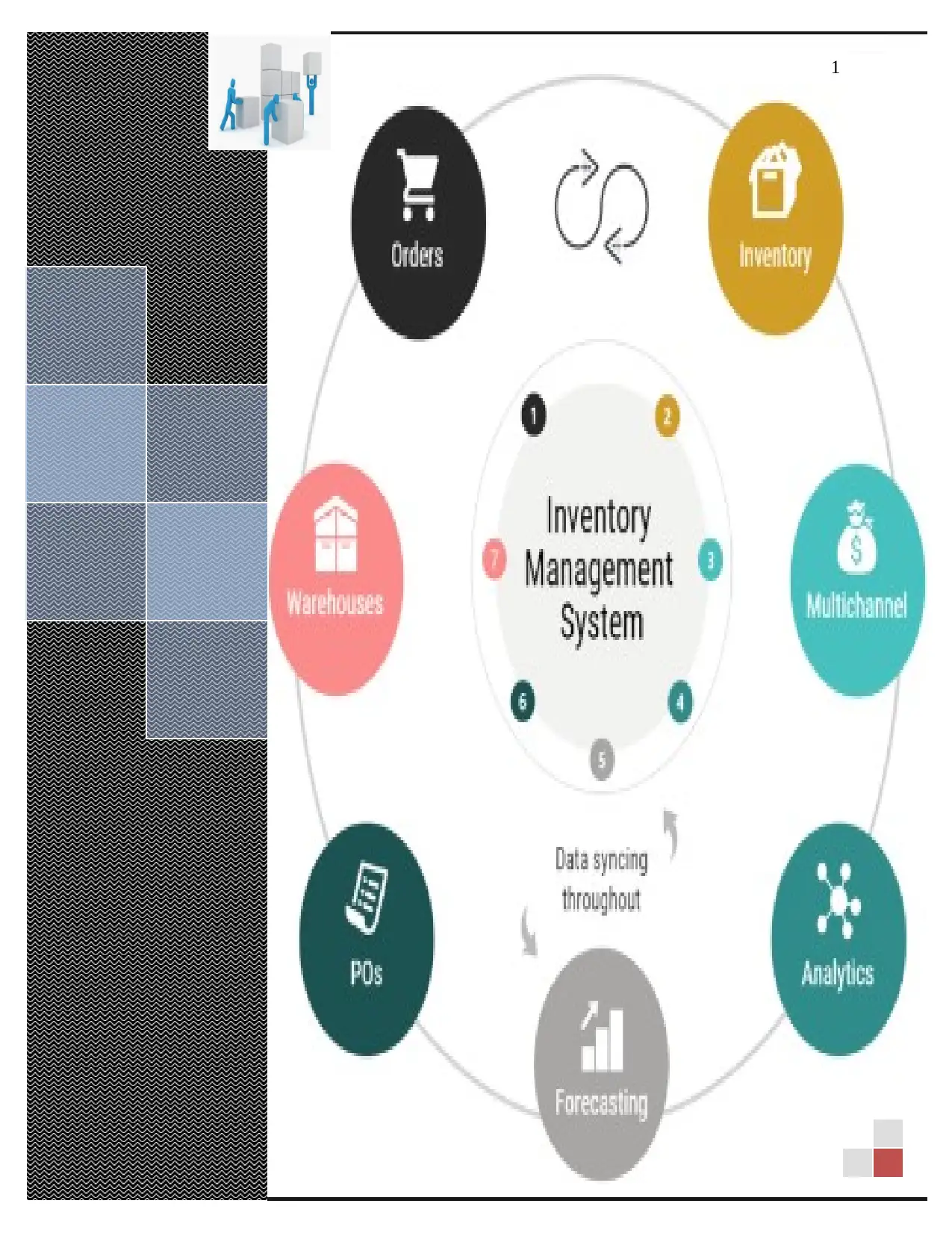
1
Paraphrase This Document
Need a fresh take? Get an instant paraphrase of this document with our AI Paraphraser
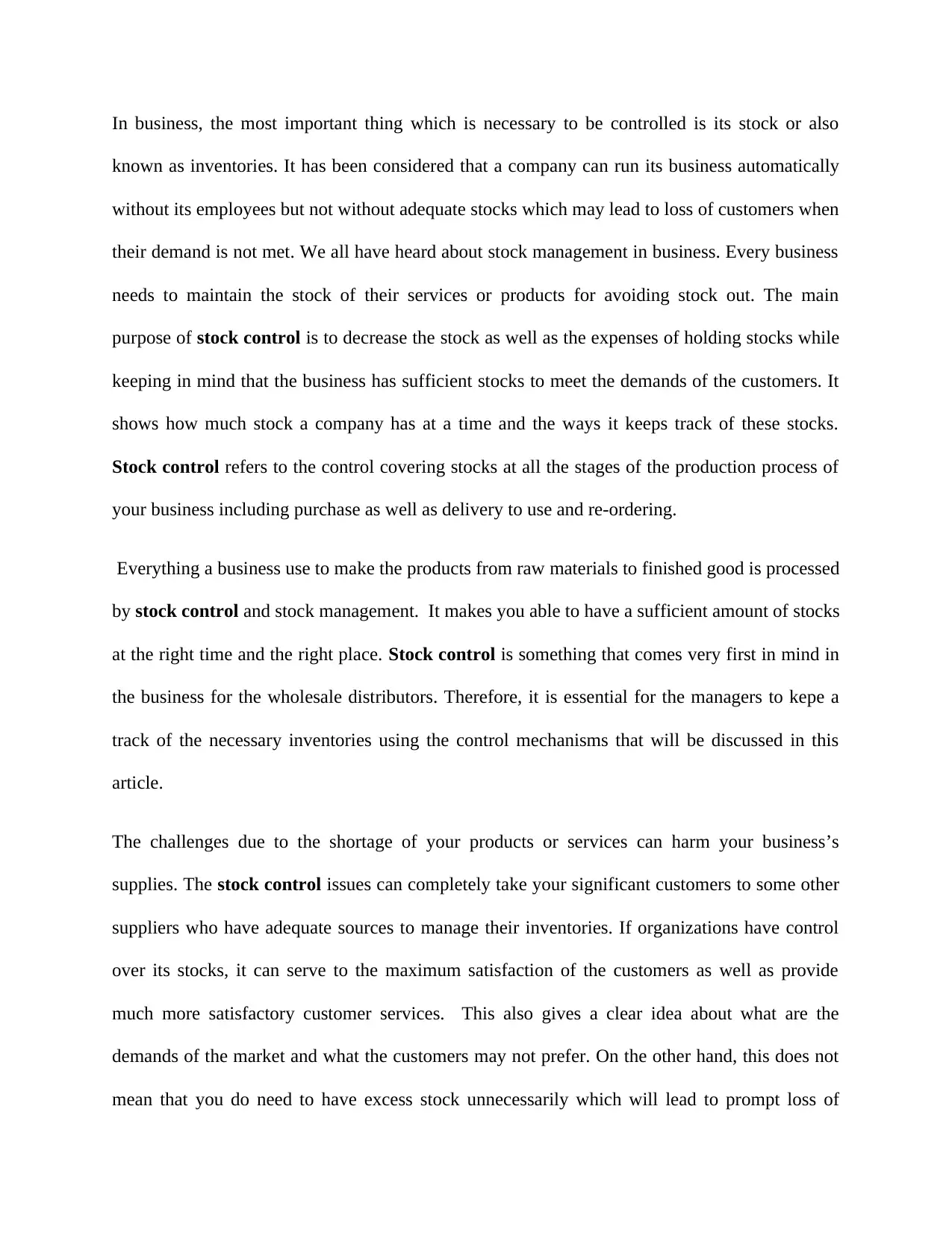
In business, the most important thing which is necessary to be controlled is its stock or also
known as inventories. It has been considered that a company can run its business automatically
without its employees but not without adequate stocks which may lead to loss of customers when
their demand is not met. We all have heard about stock management in business. Every business
needs to maintain the stock of their services or products for avoiding stock out. The main
purpose of stock control is to decrease the stock as well as the expenses of holding stocks while
keeping in mind that the business has sufficient stocks to meet the demands of the customers. It
shows how much stock a company has at a time and the ways it keeps track of these stocks.
Stock control refers to the control covering stocks at all the stages of the production process of
your business including purchase as well as delivery to use and re-ordering.
Everything a business use to make the products from raw materials to finished good is processed
by stock control and stock management. It makes you able to have a sufficient amount of stocks
at the right time and the right place. Stock control is something that comes very first in mind in
the business for the wholesale distributors. Therefore, it is essential for the managers to kepe a
track of the necessary inventories using the control mechanisms that will be discussed in this
article.
The challenges due to the shortage of your products or services can harm your business’s
supplies. The stock control issues can completely take your significant customers to some other
suppliers who have adequate sources to manage their inventories. If organizations have control
over its stocks, it can serve to the maximum satisfaction of the customers as well as provide
much more satisfactory customer services. This also gives a clear idea about what are the
demands of the market and what the customers may not prefer. On the other hand, this does not
mean that you do need to have excess stock unnecessarily which will lead to prompt loss of
known as inventories. It has been considered that a company can run its business automatically
without its employees but not without adequate stocks which may lead to loss of customers when
their demand is not met. We all have heard about stock management in business. Every business
needs to maintain the stock of their services or products for avoiding stock out. The main
purpose of stock control is to decrease the stock as well as the expenses of holding stocks while
keeping in mind that the business has sufficient stocks to meet the demands of the customers. It
shows how much stock a company has at a time and the ways it keeps track of these stocks.
Stock control refers to the control covering stocks at all the stages of the production process of
your business including purchase as well as delivery to use and re-ordering.
Everything a business use to make the products from raw materials to finished good is processed
by stock control and stock management. It makes you able to have a sufficient amount of stocks
at the right time and the right place. Stock control is something that comes very first in mind in
the business for the wholesale distributors. Therefore, it is essential for the managers to kepe a
track of the necessary inventories using the control mechanisms that will be discussed in this
article.
The challenges due to the shortage of your products or services can harm your business’s
supplies. The stock control issues can completely take your significant customers to some other
suppliers who have adequate sources to manage their inventories. If organizations have control
over its stocks, it can serve to the maximum satisfaction of the customers as well as provide
much more satisfactory customer services. This also gives a clear idea about what are the
demands of the market and what the customers may not prefer. On the other hand, this does not
mean that you do need to have excess stock unnecessarily which will lead to prompt loss of
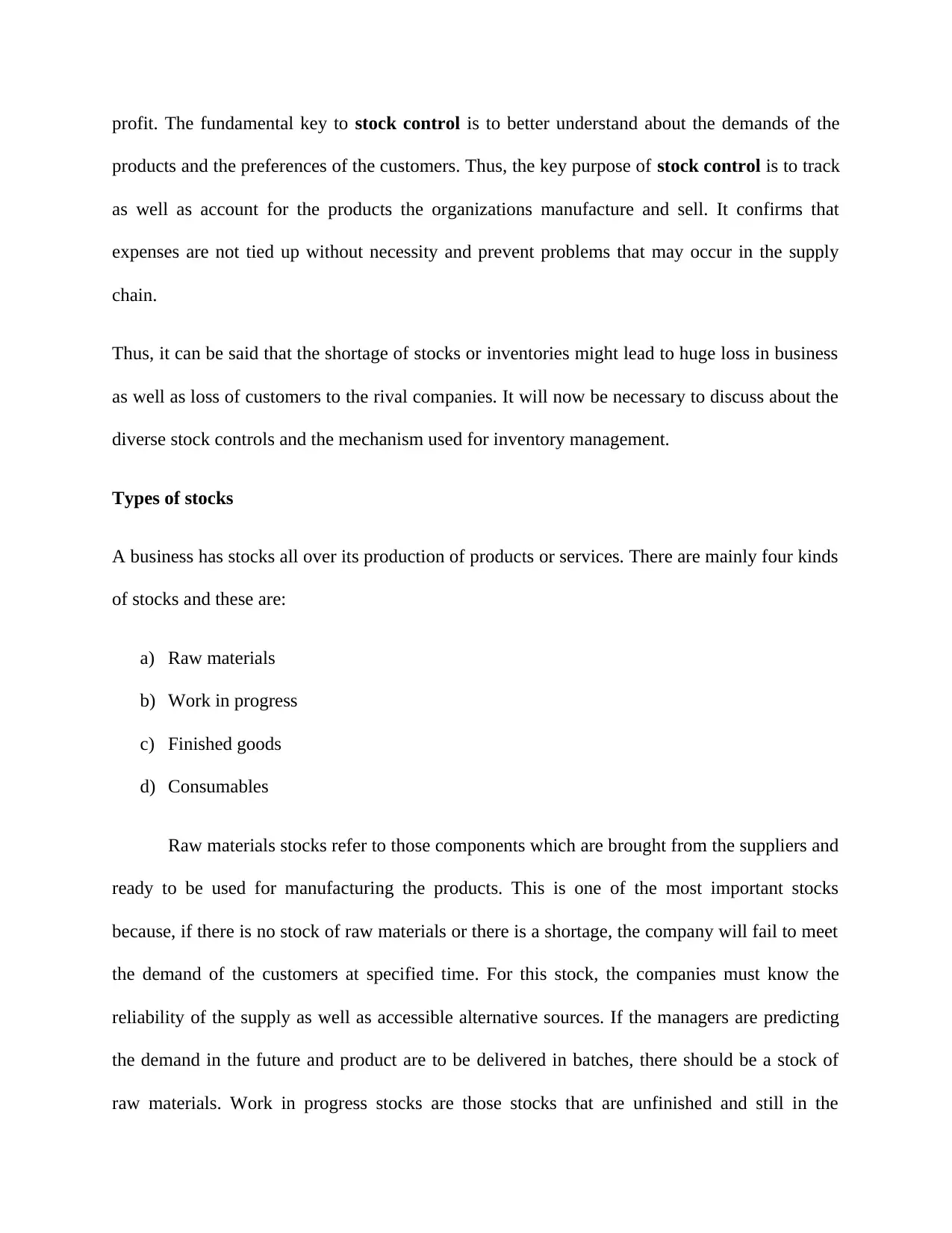
profit. The fundamental key to stock control is to better understand about the demands of the
products and the preferences of the customers. Thus, the key purpose of stock control is to track
as well as account for the products the organizations manufacture and sell. It confirms that
expenses are not tied up without necessity and prevent problems that may occur in the supply
chain.
Thus, it can be said that the shortage of stocks or inventories might lead to huge loss in business
as well as loss of customers to the rival companies. It will now be necessary to discuss about the
diverse stock controls and the mechanism used for inventory management.
Types of stocks
A business has stocks all over its production of products or services. There are mainly four kinds
of stocks and these are:
a) Raw materials
b) Work in progress
c) Finished goods
d) Consumables
Raw materials stocks refer to those components which are brought from the suppliers and
ready to be used for manufacturing the products. This is one of the most important stocks
because, if there is no stock of raw materials or there is a shortage, the company will fail to meet
the demand of the customers at specified time. For this stock, the companies must know the
reliability of the supply as well as accessible alternative sources. If the managers are predicting
the demand in the future and product are to be delivered in batches, there should be a stock of
raw materials. Work in progress stocks are those stocks that are unfinished and still in the
products and the preferences of the customers. Thus, the key purpose of stock control is to track
as well as account for the products the organizations manufacture and sell. It confirms that
expenses are not tied up without necessity and prevent problems that may occur in the supply
chain.
Thus, it can be said that the shortage of stocks or inventories might lead to huge loss in business
as well as loss of customers to the rival companies. It will now be necessary to discuss about the
diverse stock controls and the mechanism used for inventory management.
Types of stocks
A business has stocks all over its production of products or services. There are mainly four kinds
of stocks and these are:
a) Raw materials
b) Work in progress
c) Finished goods
d) Consumables
Raw materials stocks refer to those components which are brought from the suppliers and
ready to be used for manufacturing the products. This is one of the most important stocks
because, if there is no stock of raw materials or there is a shortage, the company will fail to meet
the demand of the customers at specified time. For this stock, the companies must know the
reliability of the supply as well as accessible alternative sources. If the managers are predicting
the demand in the future and product are to be delivered in batches, there should be a stock of
raw materials. Work in progress stocks are those stocks that are unfinished and still in the
⊘ This is a preview!⊘
Do you want full access?
Subscribe today to unlock all pages.

Trusted by 1+ million students worldwide
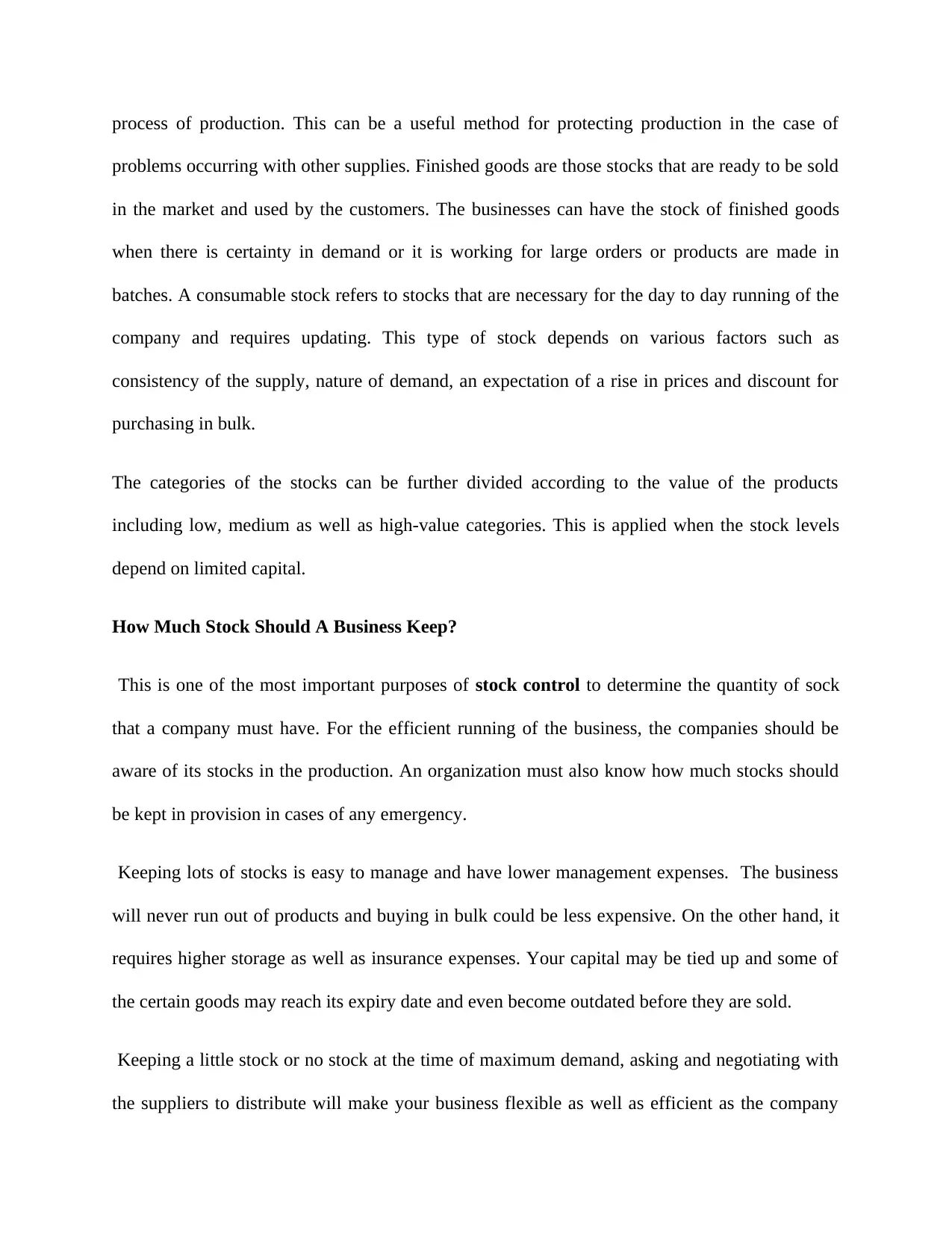
process of production. This can be a useful method for protecting production in the case of
problems occurring with other supplies. Finished goods are those stocks that are ready to be sold
in the market and used by the customers. The businesses can have the stock of finished goods
when there is certainty in demand or it is working for large orders or products are made in
batches. A consumable stock refers to stocks that are necessary for the day to day running of the
company and requires updating. This type of stock depends on various factors such as
consistency of the supply, nature of demand, an expectation of a rise in prices and discount for
purchasing in bulk.
The categories of the stocks can be further divided according to the value of the products
including low, medium as well as high-value categories. This is applied when the stock levels
depend on limited capital.
How Much Stock Should A Business Keep?
This is one of the most important purposes of stock control to determine the quantity of sock
that a company must have. For the efficient running of the business, the companies should be
aware of its stocks in the production. An organization must also know how much stocks should
be kept in provision in cases of any emergency.
Keeping lots of stocks is easy to manage and have lower management expenses. The business
will never run out of products and buying in bulk could be less expensive. On the other hand, it
requires higher storage as well as insurance expenses. Your capital may be tied up and some of
the certain goods may reach its expiry date and even become outdated before they are sold.
Keeping a little stock or no stock at the time of maximum demand, asking and negotiating with
the suppliers to distribute will make your business flexible as well as efficient as the company
problems occurring with other supplies. Finished goods are those stocks that are ready to be sold
in the market and used by the customers. The businesses can have the stock of finished goods
when there is certainty in demand or it is working for large orders or products are made in
batches. A consumable stock refers to stocks that are necessary for the day to day running of the
company and requires updating. This type of stock depends on various factors such as
consistency of the supply, nature of demand, an expectation of a rise in prices and discount for
purchasing in bulk.
The categories of the stocks can be further divided according to the value of the products
including low, medium as well as high-value categories. This is applied when the stock levels
depend on limited capital.
How Much Stock Should A Business Keep?
This is one of the most important purposes of stock control to determine the quantity of sock
that a company must have. For the efficient running of the business, the companies should be
aware of its stocks in the production. An organization must also know how much stocks should
be kept in provision in cases of any emergency.
Keeping lots of stocks is easy to manage and have lower management expenses. The business
will never run out of products and buying in bulk could be less expensive. On the other hand, it
requires higher storage as well as insurance expenses. Your capital may be tied up and some of
the certain goods may reach its expiry date and even become outdated before they are sold.
Keeping a little stock or no stock at the time of maximum demand, asking and negotiating with
the suppliers to distribute will make your business flexible as well as efficient as the company
Paraphrase This Document
Need a fresh take? Get an instant paraphrase of this document with our AI Paraphraser
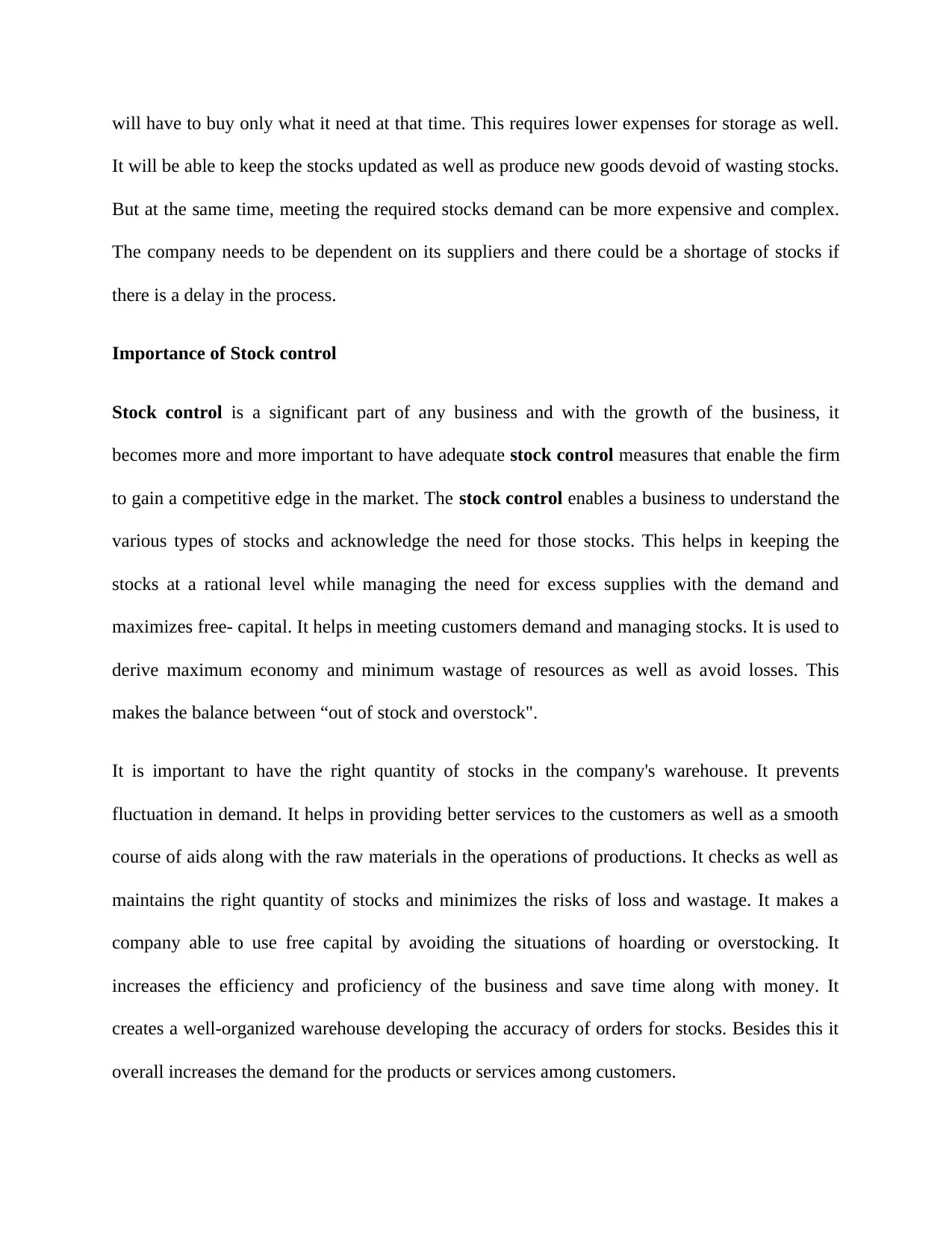
will have to buy only what it need at that time. This requires lower expenses for storage as well.
It will be able to keep the stocks updated as well as produce new goods devoid of wasting stocks.
But at the same time, meeting the required stocks demand can be more expensive and complex.
The company needs to be dependent on its suppliers and there could be a shortage of stocks if
there is a delay in the process.
Importance of Stock control
Stock control is a significant part of any business and with the growth of the business, it
becomes more and more important to have adequate stock control measures that enable the firm
to gain a competitive edge in the market. The stock control enables a business to understand the
various types of stocks and acknowledge the need for those stocks. This helps in keeping the
stocks at a rational level while managing the need for excess supplies with the demand and
maximizes free- capital. It helps in meeting customers demand and managing stocks. It is used to
derive maximum economy and minimum wastage of resources as well as avoid losses. This
makes the balance between “out of stock and overstock".
It is important to have the right quantity of stocks in the company's warehouse. It prevents
fluctuation in demand. It helps in providing better services to the customers as well as a smooth
course of aids along with the raw materials in the operations of productions. It checks as well as
maintains the right quantity of stocks and minimizes the risks of loss and wastage. It makes a
company able to use free capital by avoiding the situations of hoarding or overstocking. It
increases the efficiency and proficiency of the business and save time along with money. It
creates a well-organized warehouse developing the accuracy of orders for stocks. Besides this it
overall increases the demand for the products or services among customers.
It will be able to keep the stocks updated as well as produce new goods devoid of wasting stocks.
But at the same time, meeting the required stocks demand can be more expensive and complex.
The company needs to be dependent on its suppliers and there could be a shortage of stocks if
there is a delay in the process.
Importance of Stock control
Stock control is a significant part of any business and with the growth of the business, it
becomes more and more important to have adequate stock control measures that enable the firm
to gain a competitive edge in the market. The stock control enables a business to understand the
various types of stocks and acknowledge the need for those stocks. This helps in keeping the
stocks at a rational level while managing the need for excess supplies with the demand and
maximizes free- capital. It helps in meeting customers demand and managing stocks. It is used to
derive maximum economy and minimum wastage of resources as well as avoid losses. This
makes the balance between “out of stock and overstock".
It is important to have the right quantity of stocks in the company's warehouse. It prevents
fluctuation in demand. It helps in providing better services to the customers as well as a smooth
course of aids along with the raw materials in the operations of productions. It checks as well as
maintains the right quantity of stocks and minimizes the risks of loss and wastage. It makes a
company able to use free capital by avoiding the situations of hoarding or overstocking. It
increases the efficiency and proficiency of the business and save time along with money. It
creates a well-organized warehouse developing the accuracy of orders for stocks. Besides this it
overall increases the demand for the products or services among customers.
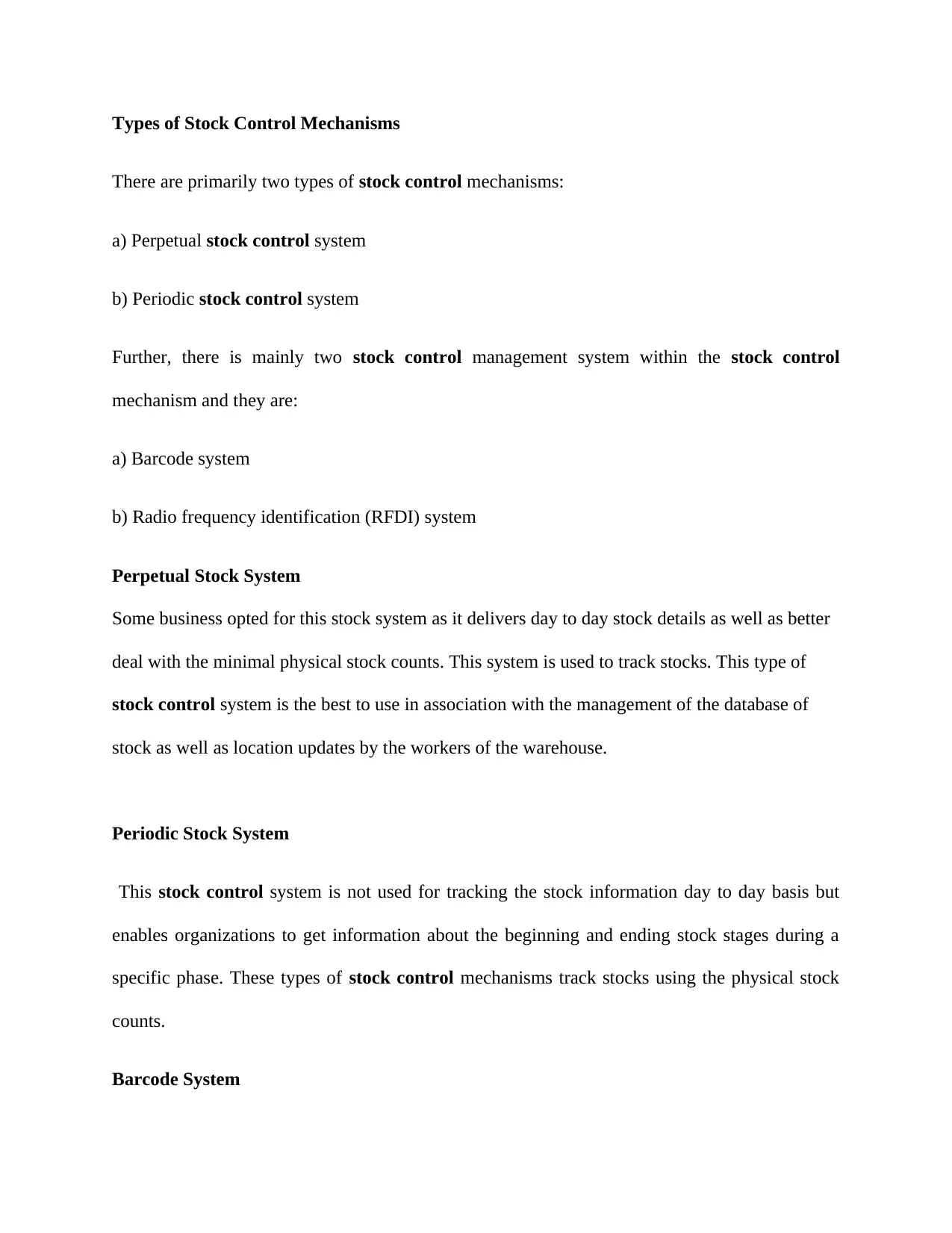
Types of Stock Control Mechanisms
There are primarily two types of stock control mechanisms:
a) Perpetual stock control system
b) Periodic stock control system
Further, there is mainly two stock control management system within the stock control
mechanism and they are:
a) Barcode system
b) Radio frequency identification (RFDI) system
Perpetual Stock System
Some business opted for this stock system as it delivers day to day stock details as well as better
deal with the minimal physical stock counts. This system is used to track stocks. This type of
stock control system is the best to use in association with the management of the database of
stock as well as location updates by the workers of the warehouse.
Periodic Stock System
This stock control system is not used for tracking the stock information day to day basis but
enables organizations to get information about the beginning and ending stock stages during a
specific phase. These types of stock control mechanisms track stocks using the physical stock
counts.
Barcode System
There are primarily two types of stock control mechanisms:
a) Perpetual stock control system
b) Periodic stock control system
Further, there is mainly two stock control management system within the stock control
mechanism and they are:
a) Barcode system
b) Radio frequency identification (RFDI) system
Perpetual Stock System
Some business opted for this stock system as it delivers day to day stock details as well as better
deal with the minimal physical stock counts. This system is used to track stocks. This type of
stock control system is the best to use in association with the management of the database of
stock as well as location updates by the workers of the warehouse.
Periodic Stock System
This stock control system is not used for tracking the stock information day to day basis but
enables organizations to get information about the beginning and ending stock stages during a
specific phase. These types of stock control mechanisms track stocks using the physical stock
counts.
Barcode System
⊘ This is a preview!⊘
Do you want full access?
Subscribe today to unlock all pages.

Trusted by 1+ million students worldwide
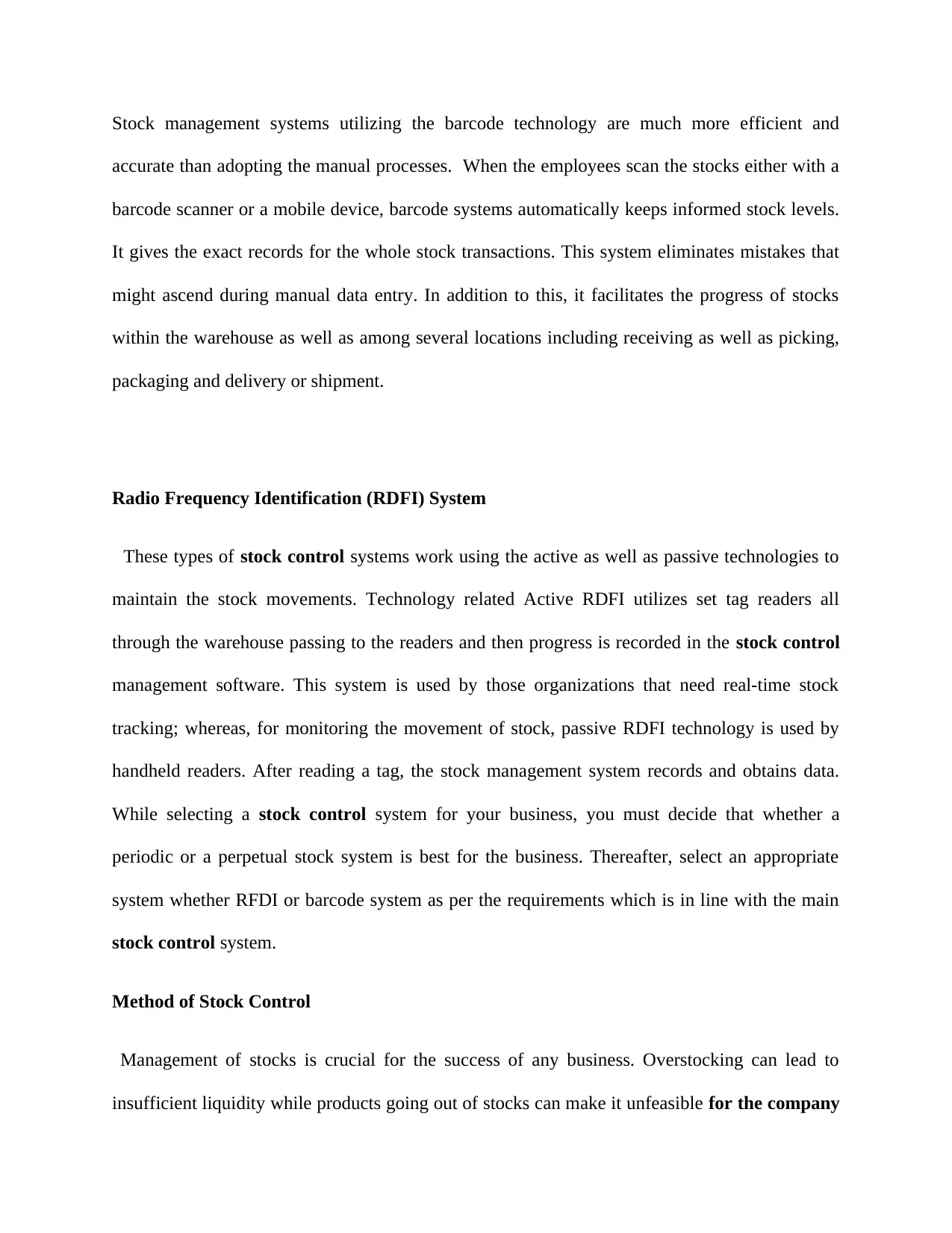
Stock management systems utilizing the barcode technology are much more efficient and
accurate than adopting the manual processes. When the employees scan the stocks either with a
barcode scanner or a mobile device, barcode systems automatically keeps informed stock levels.
It gives the exact records for the whole stock transactions. This system eliminates mistakes that
might ascend during manual data entry. In addition to this, it facilitates the progress of stocks
within the warehouse as well as among several locations including receiving as well as picking,
packaging and delivery or shipment.
Radio Frequency Identification (RDFI) System
These types of stock control systems work using the active as well as passive technologies to
maintain the stock movements. Technology related Active RDFI utilizes set tag readers all
through the warehouse passing to the readers and then progress is recorded in the stock control
management software. This system is used by those organizations that need real-time stock
tracking; whereas, for monitoring the movement of stock, passive RDFI technology is used by
handheld readers. After reading a tag, the stock management system records and obtains data.
While selecting a stock control system for your business, you must decide that whether a
periodic or a perpetual stock system is best for the business. Thereafter, select an appropriate
system whether RFDI or barcode system as per the requirements which is in line with the main
stock control system.
Method of Stock Control
Management of stocks is crucial for the success of any business. Overstocking can lead to
insufficient liquidity while products going out of stocks can make it unfeasible for the company
accurate than adopting the manual processes. When the employees scan the stocks either with a
barcode scanner or a mobile device, barcode systems automatically keeps informed stock levels.
It gives the exact records for the whole stock transactions. This system eliminates mistakes that
might ascend during manual data entry. In addition to this, it facilitates the progress of stocks
within the warehouse as well as among several locations including receiving as well as picking,
packaging and delivery or shipment.
Radio Frequency Identification (RDFI) System
These types of stock control systems work using the active as well as passive technologies to
maintain the stock movements. Technology related Active RDFI utilizes set tag readers all
through the warehouse passing to the readers and then progress is recorded in the stock control
management software. This system is used by those organizations that need real-time stock
tracking; whereas, for monitoring the movement of stock, passive RDFI technology is used by
handheld readers. After reading a tag, the stock management system records and obtains data.
While selecting a stock control system for your business, you must decide that whether a
periodic or a perpetual stock system is best for the business. Thereafter, select an appropriate
system whether RFDI or barcode system as per the requirements which is in line with the main
stock control system.
Method of Stock Control
Management of stocks is crucial for the success of any business. Overstocking can lead to
insufficient liquidity while products going out of stocks can make it unfeasible for the company
Paraphrase This Document
Need a fresh take? Get an instant paraphrase of this document with our AI Paraphraser
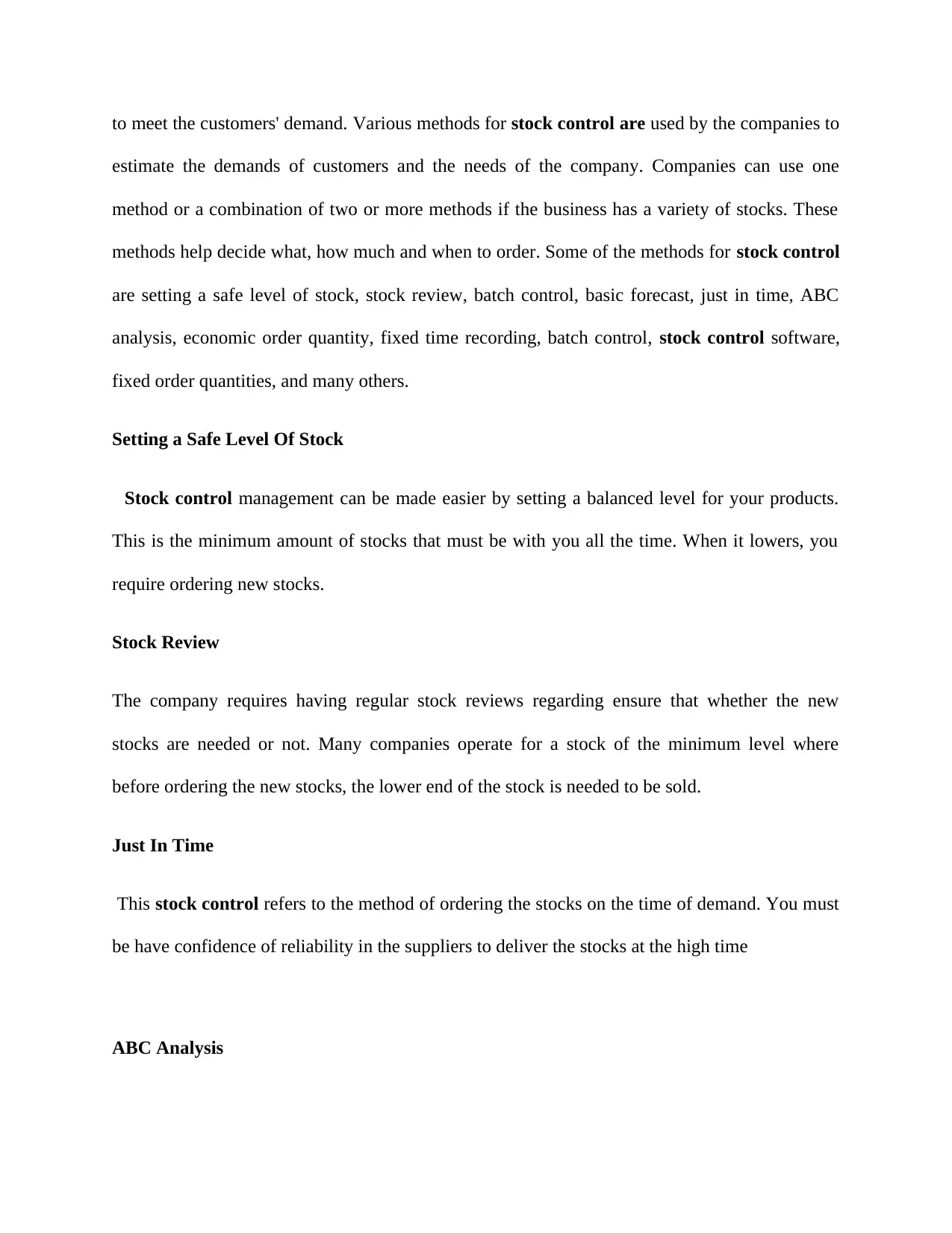
to meet the customers' demand. Various methods for stock control are used by the companies to
estimate the demands of customers and the needs of the company. Companies can use one
method or a combination of two or more methods if the business has a variety of stocks. These
methods help decide what, how much and when to order. Some of the methods for stock control
are setting a safe level of stock, stock review, batch control, basic forecast, just in time, ABC
analysis, economic order quantity, fixed time recording, batch control, stock control software,
fixed order quantities, and many others.
Setting a Safe Level Of Stock
Stock control management can be made easier by setting a balanced level for your products.
This is the minimum amount of stocks that must be with you all the time. When it lowers, you
require ordering new stocks.
Stock Review
The company requires having regular stock reviews regarding ensure that whether the new
stocks are needed or not. Many companies operate for a stock of the minimum level where
before ordering the new stocks, the lower end of the stock is needed to be sold.
Just In Time
This stock control refers to the method of ordering the stocks on the time of demand. You must
be have confidence of reliability in the suppliers to deliver the stocks at the high time
ABC Analysis
estimate the demands of customers and the needs of the company. Companies can use one
method or a combination of two or more methods if the business has a variety of stocks. These
methods help decide what, how much and when to order. Some of the methods for stock control
are setting a safe level of stock, stock review, batch control, basic forecast, just in time, ABC
analysis, economic order quantity, fixed time recording, batch control, stock control software,
fixed order quantities, and many others.
Setting a Safe Level Of Stock
Stock control management can be made easier by setting a balanced level for your products.
This is the minimum amount of stocks that must be with you all the time. When it lowers, you
require ordering new stocks.
Stock Review
The company requires having regular stock reviews regarding ensure that whether the new
stocks are needed or not. Many companies operate for a stock of the minimum level where
before ordering the new stocks, the lower end of the stock is needed to be sold.
Just In Time
This stock control refers to the method of ordering the stocks on the time of demand. You must
be have confidence of reliability in the suppliers to deliver the stocks at the high time
ABC Analysis
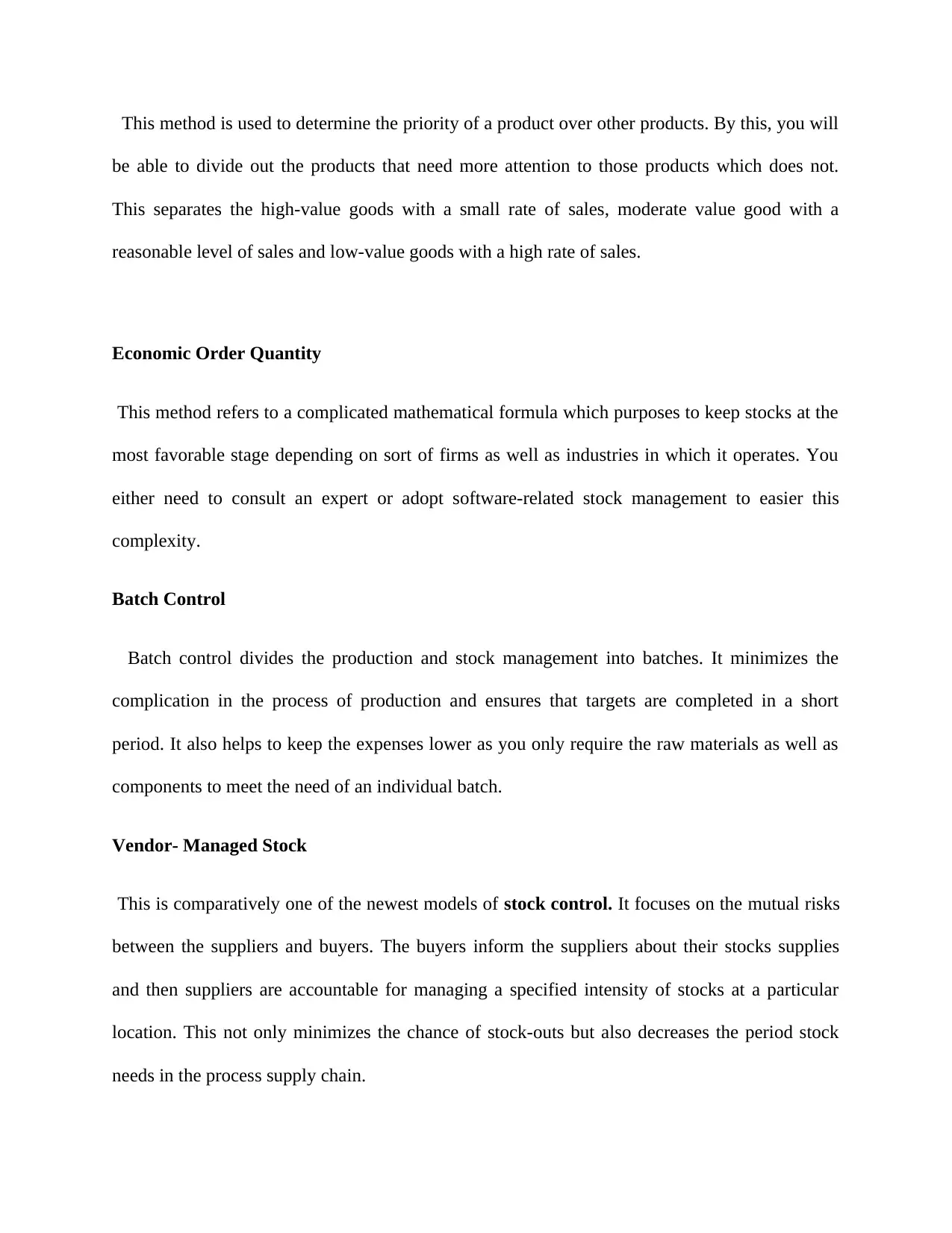
This method is used to determine the priority of a product over other products. By this, you will
be able to divide out the products that need more attention to those products which does not.
This separates the high-value goods with a small rate of sales, moderate value good with a
reasonable level of sales and low-value goods with a high rate of sales.
Economic Order Quantity
This method refers to a complicated mathematical formula which purposes to keep stocks at the
most favorable stage depending on sort of firms as well as industries in which it operates. You
either need to consult an expert or adopt software-related stock management to easier this
complexity.
Batch Control
Batch control divides the production and stock management into batches. It minimizes the
complication in the process of production and ensures that targets are completed in a short
period. It also helps to keep the expenses lower as you only require the raw materials as well as
components to meet the need of an individual batch.
Vendor- Managed Stock
This is comparatively one of the newest models of stock control. It focuses on the mutual risks
between the suppliers and buyers. The buyers inform the suppliers about their stocks supplies
and then suppliers are accountable for managing a specified intensity of stocks at a particular
location. This not only minimizes the chance of stock-outs but also decreases the period stock
needs in the process supply chain.
be able to divide out the products that need more attention to those products which does not.
This separates the high-value goods with a small rate of sales, moderate value good with a
reasonable level of sales and low-value goods with a high rate of sales.
Economic Order Quantity
This method refers to a complicated mathematical formula which purposes to keep stocks at the
most favorable stage depending on sort of firms as well as industries in which it operates. You
either need to consult an expert or adopt software-related stock management to easier this
complexity.
Batch Control
Batch control divides the production and stock management into batches. It minimizes the
complication in the process of production and ensures that targets are completed in a short
period. It also helps to keep the expenses lower as you only require the raw materials as well as
components to meet the need of an individual batch.
Vendor- Managed Stock
This is comparatively one of the newest models of stock control. It focuses on the mutual risks
between the suppliers and buyers. The buyers inform the suppliers about their stocks supplies
and then suppliers are accountable for managing a specified intensity of stocks at a particular
location. This not only minimizes the chance of stock-outs but also decreases the period stock
needs in the process supply chain.
⊘ This is a preview!⊘
Do you want full access?
Subscribe today to unlock all pages.

Trusted by 1+ million students worldwide
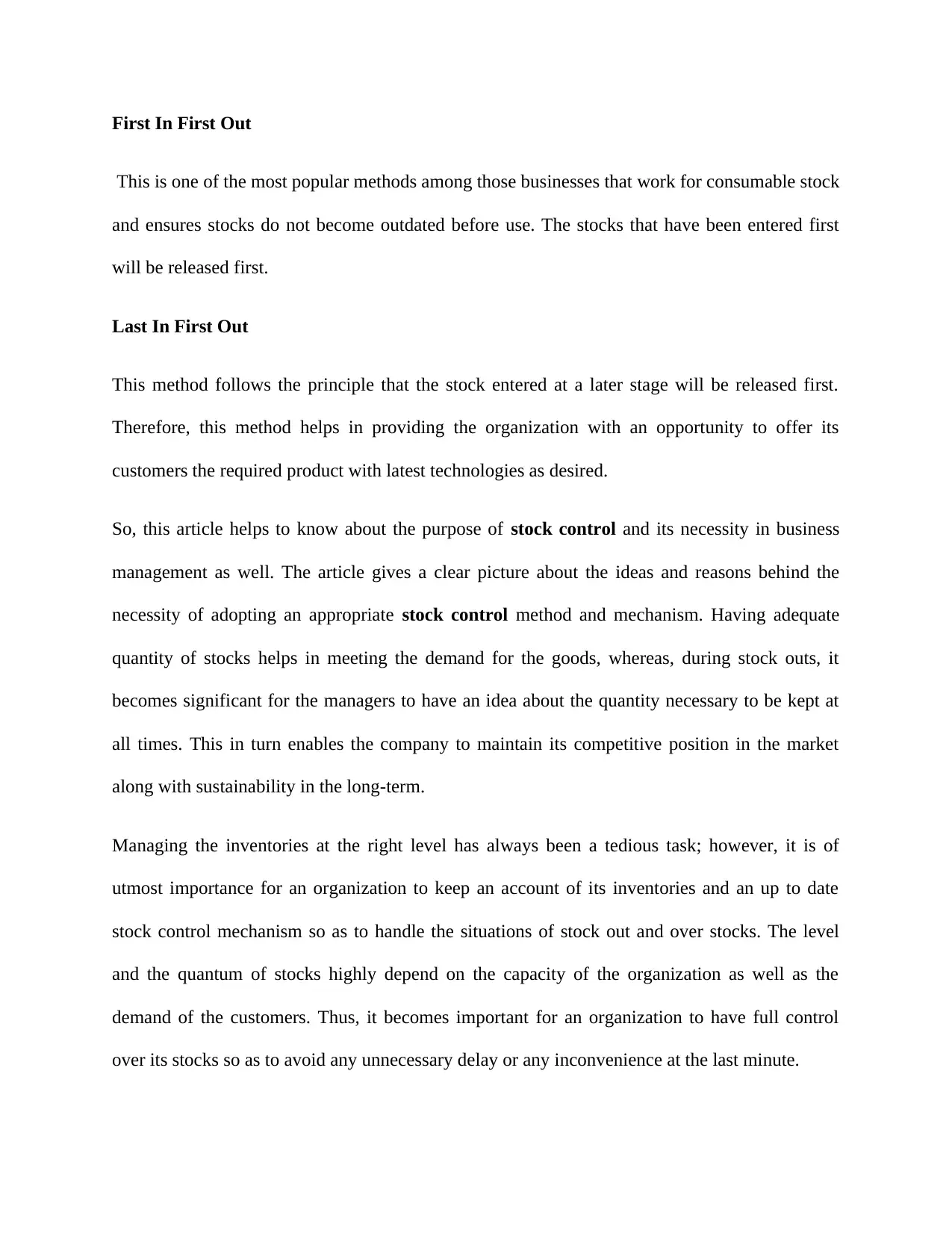
First In First Out
This is one of the most popular methods among those businesses that work for consumable stock
and ensures stocks do not become outdated before use. The stocks that have been entered first
will be released first.
Last In First Out
This method follows the principle that the stock entered at a later stage will be released first.
Therefore, this method helps in providing the organization with an opportunity to offer its
customers the required product with latest technologies as desired.
So, this article helps to know about the purpose of stock control and its necessity in business
management as well. The article gives a clear picture about the ideas and reasons behind the
necessity of adopting an appropriate stock control method and mechanism. Having adequate
quantity of stocks helps in meeting the demand for the goods, whereas, during stock outs, it
becomes significant for the managers to have an idea about the quantity necessary to be kept at
all times. This in turn enables the company to maintain its competitive position in the market
along with sustainability in the long-term.
Managing the inventories at the right level has always been a tedious task; however, it is of
utmost importance for an organization to keep an account of its inventories and an up to date
stock control mechanism so as to handle the situations of stock out and over stocks. The level
and the quantum of stocks highly depend on the capacity of the organization as well as the
demand of the customers. Thus, it becomes important for an organization to have full control
over its stocks so as to avoid any unnecessary delay or any inconvenience at the last minute.
This is one of the most popular methods among those businesses that work for consumable stock
and ensures stocks do not become outdated before use. The stocks that have been entered first
will be released first.
Last In First Out
This method follows the principle that the stock entered at a later stage will be released first.
Therefore, this method helps in providing the organization with an opportunity to offer its
customers the required product with latest technologies as desired.
So, this article helps to know about the purpose of stock control and its necessity in business
management as well. The article gives a clear picture about the ideas and reasons behind the
necessity of adopting an appropriate stock control method and mechanism. Having adequate
quantity of stocks helps in meeting the demand for the goods, whereas, during stock outs, it
becomes significant for the managers to have an idea about the quantity necessary to be kept at
all times. This in turn enables the company to maintain its competitive position in the market
along with sustainability in the long-term.
Managing the inventories at the right level has always been a tedious task; however, it is of
utmost importance for an organization to keep an account of its inventories and an up to date
stock control mechanism so as to handle the situations of stock out and over stocks. The level
and the quantum of stocks highly depend on the capacity of the organization as well as the
demand of the customers. Thus, it becomes important for an organization to have full control
over its stocks so as to avoid any unnecessary delay or any inconvenience at the last minute.
Paraphrase This Document
Need a fresh take? Get an instant paraphrase of this document with our AI Paraphraser

1 out of 11
Related Documents
Your All-in-One AI-Powered Toolkit for Academic Success.
+13062052269
info@desklib.com
Available 24*7 on WhatsApp / Email
![[object Object]](/_next/static/media/star-bottom.7253800d.svg)
Unlock your academic potential
Copyright © 2020–2025 A2Z Services. All Rights Reserved. Developed and managed by ZUCOL.




